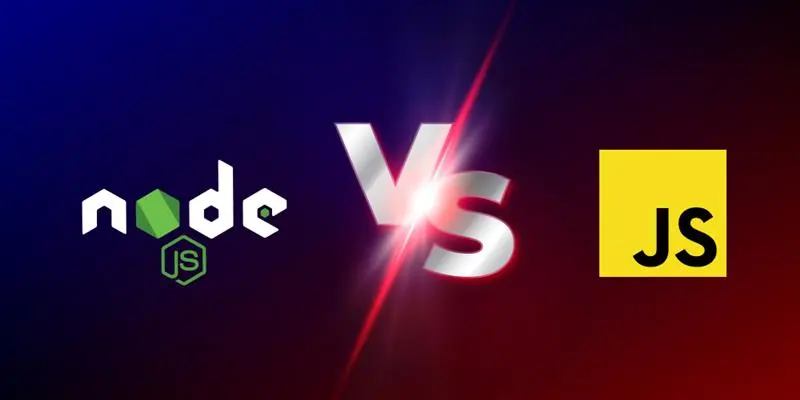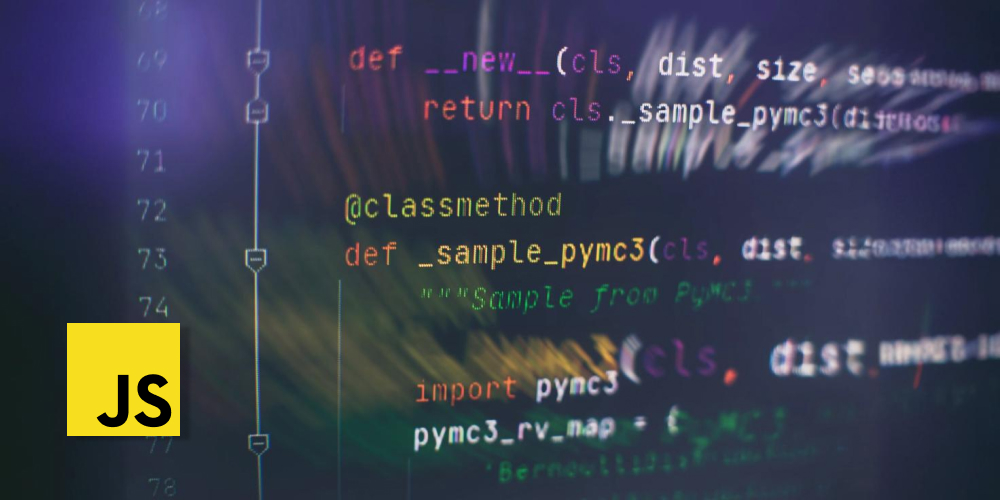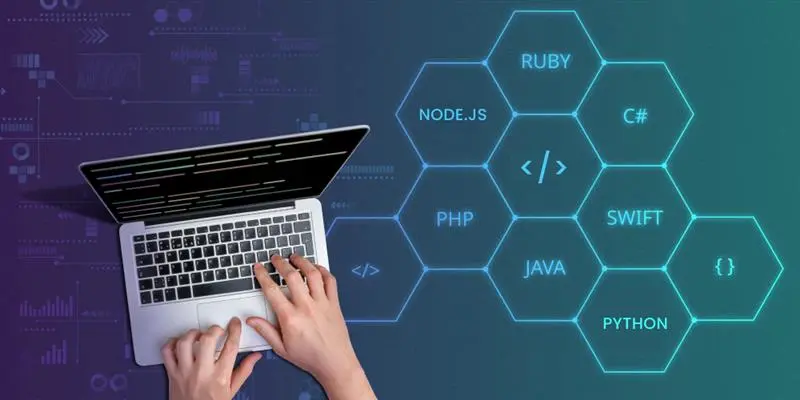Choosing the right web framework can be overwhelming with so many options available. Web developers constantly rely on modern web frameworks to perform repetitive tasks, rapid development, and bring consistency. These frameworks help them to speed up development, improve performance, and build scalable applications easily. Whether you’re just starting out or managing a team, this guide will help you choose the best framework for your needs.
In this blog, we’ll explore the top 15 modern web frameworks, including frontend, backend, and full stack options which help developers and project managers make informed decisions. If you’re planning a new project or looking to hire a developer, understanding these frameworks will help you choose the right one to boost efficiency and scalability.
What Are Web Frameworks and Their Types?
A web framework is a pre-built set of software tools and libraries that streamlines the development of web applications. With the help of these frameworks, developers easily manage common functions such as routing, templating, or database handling. The web frameworks are categorized into three main types, such as:
- Frontend Frameworks (handles the user interface and user interactions)
- Backend Frameworks (manage tasks related to database, server, and application logic)
- Full-stack Frameworks (merge both frontend and backend performances)
Choosing the right web development framework will speed up the development process, bring consistency, and allow scaling of applications.
Top 5 Frontend Frameworks
Frontend frameworks are important to provide a better user experience and the same designs throughout the application. The following modern web frameworks are getting popular in 2025:
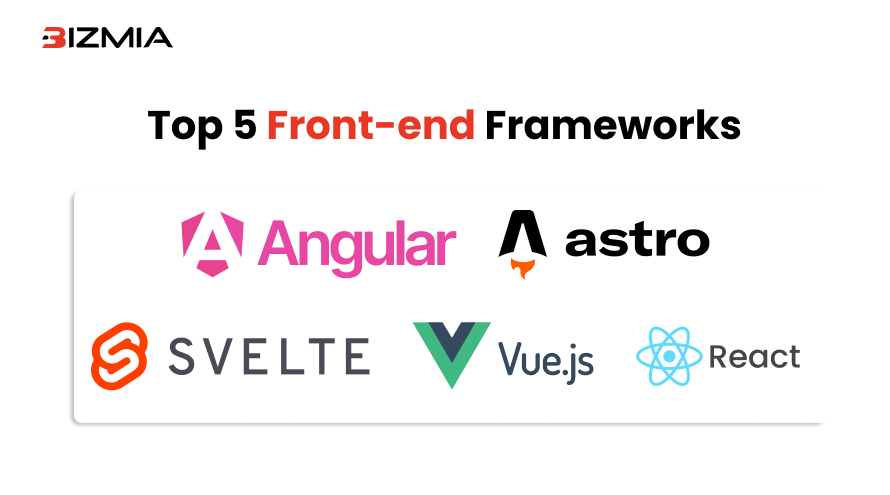
1. React.js
One of the reasons it lies at the top of the list of frontend frameworks is because it was created by Meta (Facebook). It is built with JavaScript, which makes React applications easily integrate with advanced web technologies. The key features of React are:
- Virtual DOM
- Component-based architecture
- One-way data binding
- JSX (JavaScript XML)
It is suitable for building fast and responsive apps for single-page applications (SPAs) or complex UIs.
2. Vue.js
It is a lightweight JavaScript framework that is easy to integrate with other libraries. It offers developers flexibility, ease of use, and a strong ecosystem. The following main features of Vue.js help frontend developers:
- Reactive data binding
- Modular architecture
- Vue CLI
- Single-File Components for HTML, CSS, and JavaScript
The best use cases for Vue are dashboards, e-commerce frontends, and responsive UIs.
3. Angular
Angular is maintained and developed by Google and is one of the most popular frontend frameworks that is built on TypeScript. It offers full-fledged features to developers to build complex projects effortlessly, such as:
- Two-way data binding
- Built-in routing and navigation
- Dependency Injection
- Angular CLI
It is ideal for enterprise-grade businesses that demand stability, security, scalability, and high performance.
4. Svelte
It is also a well-known JavaScript framework that helps developers build user interfaces. Although it is easy to learn but still develops high-performing applications. The main features that make Svelte different from other modern web frameworks are:
- No virtual DOM
- Built-in reactivity
- Code is easy to read and write
- Reusable components
It is perfect for small to medium-sized web applications like dashboards and admin panels.
5. Astro
It is an advanced and rapid web development framework. It is built using JavaScript and TypeScript. The highlighted features of Astro are as follows:
- Component island architecture
- Supports various frameworks
- Static Site Generation (SSG)
- Built-in image upgradation
All features of Astro make sure applications work fast and smoothly. Additionally, in most cases, developers use it to build content-focused websites such as blogs and marketing sites.
Top 5 Backend Frameworks
Backend frameworks help to build scalable, high-performing, and secure applications. The following notable frameworks are for anyone working with backend development technologies in 2025:
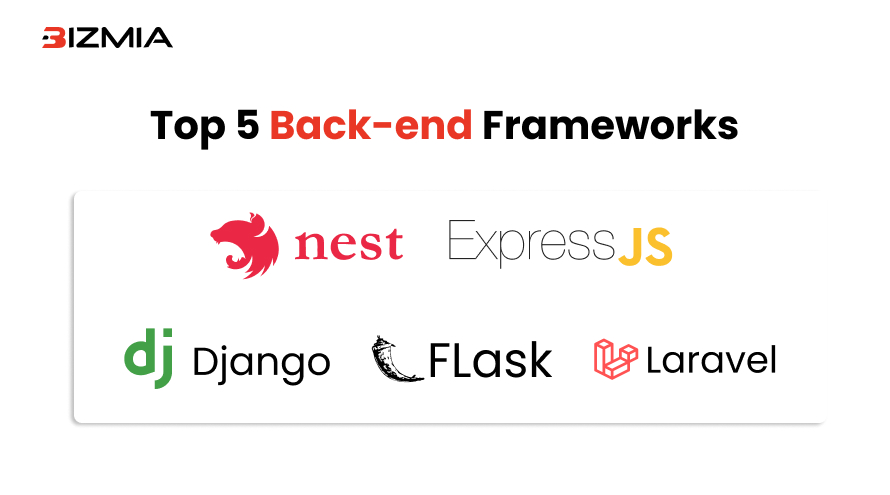
1. Express.js
It is a fast and flexible backend framework, also named Node.js + Express. The reason is that it’s a minimal server-side version of Node.js. The main characteristics of Express.js are as follows:
- Middleware structure
- Rapid routing
- Seamless integration
- REST API development
It is ideal for real-time applications, and backend SPAs.
2. NestJS
It is another node.js backend framework, however, built on TypeScript. It helps backend developers to build scalable and efficient applications by using the following features:
- Modular architecture
- Built-in dependency injection
- Powerful CLI
- Ready-to-use testing tools
Almost all features of Nest.JS are the same as Angular, but it is a backend framework. The best use cases are enterprise-level applications, RESTful or GraphQL APIs, and real-time applications.
3. Django
It is the high-ranking Python web framework that develops secure applications and speeds up development. It follows batteries-included philosophy which offers several built-in tools, such as authentication methods, URL routing, and form handling. Moreover, it has the following key features:
- Auto-generated admin panel
- ORM (Object-Relational Mapping)
- Inherent security
- Rich ecosystem
It is ideal for Content Management Systems (CMS), e-commerce websites, and social media platforms.
4. Flask
It is also a Python framework, but it is lightweight. It is a preferred choice for developers to build web applications and APIs because Flask is easy to use. The following characteristics of Flask are highlighted:
- Offers flexibility
- Built-in development server
- Minimal boilerplate
- RESTful Request Handling
The ideal scenario for Flask would be simple websites or landing pages and startups.
5. Laravel
Laravel is the front-runner among PHP frameworks, and the reasons for its popularity are its powerful tools and developer-friendly features, such as:
- Model View Controller (MVC) architecture
- Eloquent ORM
- Artisan CLI
- Blade templating engine
It is a perfect fit for e-commerce platforms, admin panels, or SaaS products.
Top 5 Full-Stack Frameworks
Full-stack frameworks are also known as meta frameworks as they simplify development and produce high-quality results. Some of the best full-stack frameworks are as follows:
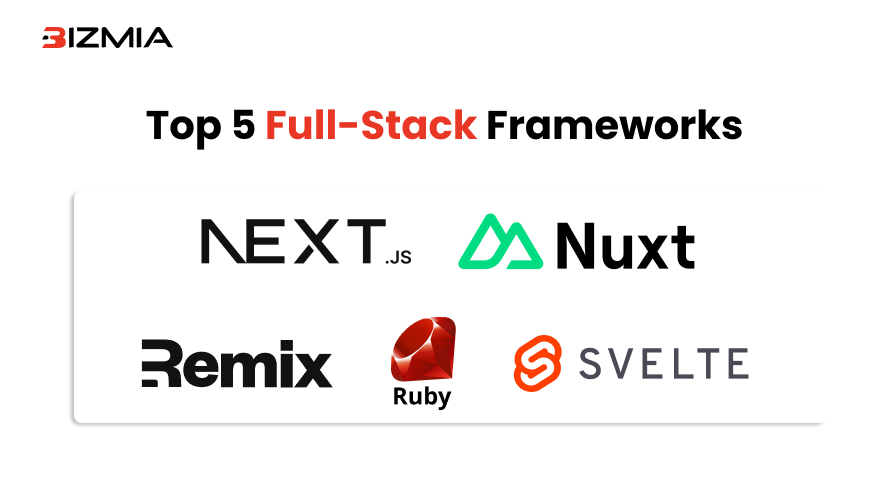
1. Next.js
It is built on React as a full-stack framework, which ensures developers build fast and advanced web applications. It uses Versel as a cloud computing platform to perform server-side and client-side tasks smoothly. It offers the following key features:
- Server-Side Rendering (SSR)
- Static Site Generation (SSG)
- Built-in image enhancement
- Supports TypeScript
The best use cases for the Next.js framework are SaaS dashboards and E-commerce platforms.
2. Nuxt.js
It is a full-stack framework that is used to build high-performing Vue.js applications. It offers several features such as:
- File-based routing
- Modular architecture
- Server-Side Rendering (SSR)
- Compatible with Vue 3 and TypeScript
With the help of Nuxt.js developers can effortlessly build e-commerce stores and Vue.js applications.
3. SvelteKit
It brings full-stack abilities to Svelte projects which ensures Svelte developers build advanced web applications. It offers the following frontend and backend features:
- Built-in API routes
- File-based routing
- Support TypeScript
- Rapid performance focused
With the help of SvelteKit developers build high-performing apps, static websites, and dynamic parts.
4. Remix
It is also a React-based full-stack framework that offers developer-friendly features. It allows client-side and server-side functions to React applications with the following features:
- Nested Routing
- Loads data on the server
- Built-in error detection and form handling
- TypeScript integration
Developers can build comprehensive websites that are SEO-friendly with the help of Remix.
5. Ruby on Rails
It is also known as Rails which is written in Ruby. It allows developers to write modular and readable code with the following features:
- MVC architecture
- ActiveRecord ORM
- Built-in testing and security features
- Scaffolding (automatic code generation)
It allows developers to quickly launch websites for startups and also helps in developing SaaS platforms and CMS.
How to Pick the Right Framework?
It is not an easy task to select the right modern web framework from the plenty of options in 2025. By following these steps, you can take the right decision:
- Evaluate your project requirements, which depend on the app’s complexity, project type, and targeted platform.
- Examine the team’s expertise in languages such as JavaScript, Python, PHP, or Ruby. Ensure that your team is comfortable with the framework you are selecting.
- Review performance needs, if you want high-performing applications, consider choosing SvelteKit for startups or Angular for enterprise-grade applications.
- Consider community support and the ecosystem, which will make development easy.
- Be prepared for scalability if you have plans to grow your business; it’s crucial to select a framework that handles scalable architectures.
The advanced web development framework will keep your application up-to-date and future-ready for new technologies, user demands, and changing business trends.
Conclusion
The web development frameworks are getting more vibrant in 2025. There are a lot of options for developers to select from the best JavaScript frameworks like Vue.js and Svelte to powerful backend tools like Django, Flask, and Laravel. Whether it’s frontend, backend, or full-stack, understanding and working with the right modern web frameworks is equally important for developers and businesses to stay ahead in the market.
FAQs
1. What are web development frameworks, and why are they important?
Modern web development frameworks are a pre-built set of software tools and libraries that simplify development and provide stability to applications.
2. What are the top backend frameworks in 2025?
The top 5 backend frameworks in 2025 are Express.js, NestJS, Django, Flask, and Laravel, each providing different features and project types.
3. Which full-stack frameworks should developers consider in 2025?
Developers should consider Next.js, Nuxt.js, SvelteKit, Remix, and Ruby on Rails for full-stack development because they provide smooth integration with frontend and backend technologies.
4. How do I choose the right framework for my project?
Evaluate your project requirements, examine team expertise in languages, review performance needs, consider community support and ecosystem, and prepare a scalability plan.
5. Which frontend frameworks are leading the industry in 2025?
The 5 prominent frameworks for frontend developers in 2025 are React.js, Vue.js, Angular, Svelte, and Astro.

